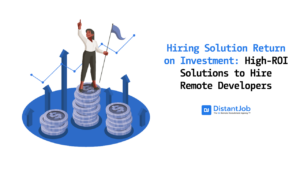With AI and machine learning specialist demand projected to climb by 40%, and AI-related job postings witnessing a more than 250% increase since 2021, the emergence of roles such as AI prompt engineers, AI artists, and AI writers/content creators highlights the evolving landscape of AI-driven competitive advantage. To capitalize on this trend, employers must hire AI engineers who not only possess robust technical acumen but also demonstrate the creative problem-solving skills necessary to generate high-quality, AI-powered outputs. This dual competency is particularly vital for roles like AI prompt engineers, who exemplify the blend of technical proficiency and creativity essential for leveraging AI technologies to their fullest potential.
Here is an overview of what you need to consider when you hire an AI engineer:
However, it is important to make a distinction between AI, machine learning, and deep learning.
Generally speaking, machine learning is a subset of AI development. These techniques enable computers to analyze data coming from AI applications. To simply put it, AI is the ability to mimic human actions – quickly and more efficiently. Machine learning is the ability to mimic how humans learn, adapting their responses.
Finally, deep learning is a subset of machine learning. In short, this model allows computers to solve complex problems like speech recognition. It uses neural networks able to work with more neurons and layers on multiple levels of interconnectivity. We’re still a long way off from mimicking the human brain in all its complexity, but we’re moving in that direction.

What Does An AI Engineer Do?
Artificial Intelligence (AI) technologies like Midjourney and ChatGPT have sparked widespread interest and excitement, heralding a new era in innovation and digital exploration. These AI-powered tools are not just novelties but transformative forces, reshaping how we create, communicate, and solve complex problems.
Behind these groundbreaking advancements stand the AI engineers, the unsung heroes whose expertise and creativity fuel the development of AI systems that captivate our imagination and expand our technological horizons. They are the keystones in the bridge to the future, meticulously crafting the algorithms and models that make AI not just a possibility but a tangible, influential reality in our everyday lives.
Here are the range of activities of an AI engineer:
- Analysis and association of AI principles into a business perspective environment.
- Application of AI and machine learning techniques for image analysis and reconstruction solving complex scenarios.
- Development of AI-driven solutions modeling human behavior to complete specific tasks.
- Evaluation of the performance of applications in artificial intelligence and machine learning domains to improve efficiency.
When it comes to hiring, it is essential to evaluate your project’s specific priorities and needs. Your AI engineer will work daily with your team, taking over multiple tasks. Based on the complexity of your application, think carefully about the level of expertise you need and the type of personality that can fit with your team.
Roles and Responsibilities
- Set up and monitor AI development and production infrastructure.
- Identify transfer learning opportunities and new training datasets.
- Convert machine learning models into application program interfaces (APIs) to allow the use of other applications.
- Create APIs helping customers putting results of AI models into operations.
- Build AI models and illustrate the different components.
- Build data ingestion and data transformation infrastructure.
- Automate infrastructure that the data science team uses.
- Statistical analysis.
- Set up and manage AI development and product infrastructure.
Skills
Statistics, probability, and linear algebra
Your engineer must master algorithms, statistics, algebra, and calculus to build AI models. In addition, your new hire needs a background with probability systems to work with standard machine learning models such as Hidden Markov, Gaussian mixture, and Naive Bayes models.
Programming skills
Programming languages like C++, Java, R, and Python are a must simply because any Ai model utilizes coding languages.
Analytical skills
A core part of an AI engineer’s job is reviewing and interpreting data. Analytic skills and the ability to read statistics are crucial.
Communication & Collaboration skills
Your AI engineer will closely collaborate with your team, from technical information to brainstorming on project development. In addition, your engineer will illustrate technical processes to clients and possible investors. Therefore, good interpersonal and communication skills are essential in the long-run perspective.
Business Thinking
Like any development project, AI requires quick problem-solving and critical thinking to build prototypes and test different solutions. You need someone able to transform technical ideas into practical business strategies that your marketing can promote. In addition to computing skills, your engineer needs an understanding of business planning, a target audience overview, and the ability to analyze competitors.
How To Hire AI Engineers?
Finding a good AI engineer is even harder than understanding the type of skills you need for your business. Looking at the good side of things, most developers and programmers are getting training on AI skills. On the flip side, once you start your research, you’ll feel as if looking for a needle in a haystack.
Before writing down your job description, think carefully about the type of candidate you want. For example, if you have a retail website and want to improve the chatbot UX and track your customers’ actions, that points you in a certain direction. You can already isolate a few expectations in the job description and ask for possible solutions during the hiring process.
Having these goals in mind, do you want a stable team member to grow your project? Or do you need temporary support on a specific feature of your project?
In the second case, an effective strategy is hiring through freelance platforms. If you hire remotely, you can research specific geographical areas. Some countries invest more in tech education systems than others, and specific areas can offer a better quality range of candidates. If you want a long-lasting collaboration, freelancing isn’t the best option. Generally speaking, engineers working on temporary projects tend to have more clients or simply have different plans for the future.
Let’s go back to the example of a retail website. If you are planning to launch several products or services in the next five years, it’s better to have a full-time developer. In the long run, a full-time employee gives you continuity and the opportunity to build a solid development team. Can you imagine working on the same project while changing team members every year? You would end up spending all of your time and resources on training people.
Besides the type of contract that suits you best, you can start the hiring process with recruiters/headhunters, or by yourself. In the first case, you can rely on a solid pool of candidates and expertise in selecting candidates and skills. In the second case, consider the time you will spend screening candidates and avoiding scams. More importantly, make sure to isolate the specific needs you have to ask the right questions and pick the best AI engineer for your project.
5 Critical Artificial Intelligence (AI) Engineer Interview Questions
Last but not least, here are some samples of interview questions. Remember that the role of an AI engineer can be different depending on the project. The possibilities to integrate machine learning and AI into a project are almost endless. So, think carefully about what you need and its potential, and make questions based on your needs – instead of asking about random skills!
1. Explain the different algorithms used for hyperparameter optimization.
- Grid Search: Grid search trains the network for every combination. it uses two sets of hyperparameters; learning rate; and the number of layers. Then evaluates the model with Cross-Validation techniques.
- Random Search: It randomly samples the search space and evaluates sets from a particular probability distribution. For example, instead of checking all 10,000 samples, it randomly selects 100 parameters to check.
- Bayesian Optimization: This includes fine-tuning the hyperparameters by enabling automated model tuning. The model to approximate the objective function is called the surrogate model (Gaussian Process). Bayesian Optimization uses Gaussian Process (GP) function. The aim is to get posterior functions and make predictions based on prior functions.
2. Explain the logic behind targeted marketing. How can Machine Learning help with this?
Target marketing refers to a group of potential buyers of a company product. Consumers who form a target market have similar characteristics such as buying geography; buying power; demographics; and incomes. AI can help to identify the target market and boost the development of marketing plans.
Target Marketing makes the promotion, pricing, and distribution of your products and/or services easier and more cost-effective. AI systems can improve your websites by attracting new business; increasing your sales; and growing the company.
Machine Learning in targeted marketing:
- Text Analytics Systems: The applications for text analytics range from search applications; text classification; named entity recognition; to pattern search and replace applications.
- Clustering: With applications including customer segmentation, fast search, and visualization.
- Classification: Decision trees and neural network classifiers allow text classification in marketing.
- Recommender Systems: Analyze your marketing data.
- Market Basket Analysis: It explains the combinations of products that frequently co-occur in transactions.
3. How can AI be used in detecting fraud?
Artificial Intelligence is used in Fraud detection problems. You can implement Machine Learning algorithms for detecting anomalies and studying hidden patterns in data.
Here are the approaches for detecting fraudulent activities:
- Data Extraction: At this stage, you can collect and perform data with a survey or web scraping. If you’re trying to detect credit card fraud, you collect the customer’s information. It includes transactional, shopping, personal details, etc.
- Data Cleaning: At this stage, you remove redundant data. Any inconsistencies or missing values may lead to wrongful predictions. Therefore, you must deal now with inconsistencies.
- Data Exploration & Analysis: This is the most important step in AI. Here, the AI studies the relationship between various predictor variables. For example, if a person spent an unusual amount of money on a particular day, the chances of a fraudulent occurrence are very high. This is the time to detect and understand such patterns.
- Building a Machine Learning Model: There are many machine learning algorithms for detecting fraud. One example is Logistic Regression to classify algorithms. It can classify events into two classes: fraudulent and non-fraudulent.
- Model Evaluation: Here, you test the efficiency of the machine learning model. If there is any room for improvement, you can implement the model’s accuracy performing parameter tuning.
4. A bank manager receives a data set containing 1000s records of applicants for a loan. How can AI help the manager understand which loans he can approve? Explain.
A KNN algorithm will classify the applicant’s loan request into two classes:
- Approved
- Disapproved
K Nearest Neighbour is a Supervised Learning algorithm. It classifies a new data point into the target class depending on the features of its neighboring data points.
You can carry out the following steps to predict whether a loan must be approved or not:
- Data Extraction: At this stage, you collect and perform data a survey or web scraping. The machine must collect consumers’ data such as account balance; credit amount; age; occupation; loan records, etc. To clarify, by using this data, we can predict whether or not to approve the loan of an applicant.
- Data Cleaning: At this stage, you must remove the redundant variables. For example, variables such as Telephone, Concurrent credits, etc. are not relevant, and you can remove them.
- Data Exploration & Analysis: This is the most important step in AI. Here, you study the relationship between various predictor variables. For example, if a person has a history of unpaid loans, then the chances are that he might not get approval on his loan applicant. Therefore, such patterns must be detected and understood at this stage.
- Building a Machine Learning model: There is n number of machine learning algorithms to predict whether an applicant loan request is approved or not. For instance, K-Nearest Neighbor is a classification and regression algorithm. It will classify the applicant’s loan request into two classes: Approved and Disapproved.
- Model Evaluation: Here, you test the efficiency of the machine learning model. In addition, you can implement the model’s accuracy performing parameter tuning.
5. You’ve won a 2-million-dollar worth lottery’. We all get such spam messages. How can AI be used to detect and filter out such spam messages?
To understand spam detection, let’s take the example of Gmail. Gmail uses machine learning to filter spam messages from our inbox. These spam filters can classify emails into two classes: spam and non-spam emails.
Let’s understand how spam detection is done using machine learning:
- A machine learning process always begins with data collection. Google has data centers to store the customer’s data.
- It follows data cleaning. In short, you eliminate unnecessary stop words and punctuations. So, only the relevant data can create a precise machine learning model. Therefore, you remove stop-words such as ‘the,’ ‘and,’ ‘a’ in this stage.
- After that, you work on data exploration and analysis. That is to say, certain words or phrases pop up in spam emails. Words like “lottery,” “earn,” “full-refund” indicate that the email is more likely to be a spam one.
- After retrieving useful insights from data, you build a machine learning model. Machine learning algorithms like Logistic Regression classify emails as either spam or non-spam. The machine learning model uses the training dataset. This data is used to train the model and make it learn by using past user email data.
- This stage is followed by model evaluation. In this phase, the model is tested using the testing data set, which is nothing but a new set of emails. After that, the machine learning model is graded based on the accuracy with which it was able to classify the emails correctly.
- Once the evaluation is over, any further improvement in the model can be achieved by tuning a few variables/parameters. This stage is also known as parameter tuning. Here, you basically try to improve the efficiency of the machine learning model by tweaking a few parameters that you used to build the model.
- The last stage is deployment. Here the model is deployed to the end-users, where it processes emails in real-time and predicts whether the email is spam or non-spam.
[Source for questions: Edureka.com]
Now You Know
To sum up, an AI engineer is a versatile role that requires multiple skills and qualifications. However, if you find the right one for your project, AI systems can support and contribute to your business implementing your processes and quality production. Besides spotting the right skills, hiring new candidates is always challenging. Technical expertise isn’t enough without collaborative skills – especially if you want a full-time remote engineer to build a long-lasting relationship.
If you need help with tedious interview processes and endless CVs screening, just contact us. We can support you through the whole hiring process, helping you out with interviews and HR paperwork (even after finding the perfect candidate for you). For any questions, knock on our virtual door!




